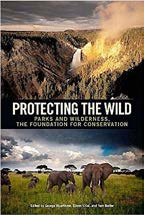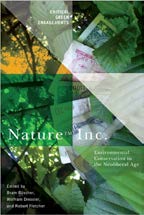April 2016 | Volume 22, Number 1
JOHN SHULTIS, BOOK REVIEW EDITOR
Protecting the Wild: Parks and Wilderness, the Foundation for Conservation
Edited by George Wuerthner, Eileen Crist, and Tom Butler. 2015. Island Press, Washington, DC. 392 pp. $24.95 (pb).
NatureTM Inc. : Environmental Conservation in the Neoliberal Age
Edited by Bram Büscher, Wolfram Dressler, and Robert Fletcher. 2014. University of Arizona Press, Tucson. 304 pp. $60.00 (hc).
Since the mid-2000s, the traditional use of protected areas as the primary form of global conservation of biodiversity has come under increasing criticism. In addition to the earlier criticisms of the wilderness concept from a relativist perspective (e.g., William Cronon’s work), some researchers and global conservation agencies began to expand on these challenges to wilderness conservation by suggesting that, inter alia, (1) the use of protected areas for conservation has been a failure, and new approaches were needed; (2) there is no such thing as wilderness (untouched natural areas) left in the world, so conservationists should see themselves as “gardeners” of working, modified landscapes; and (3) the concept of ecosystem services (championed by the United Nations) and the associated use of market-based approaches to preserve these services should be the focus of the “new” conservation. These and related criticisms of contemporary wilderness and global conservation were discussed in Keeping the Wild: Against the Domestication of Earth, a previous companion of Protecting the Wild, the first book reviewed here.
Protecting the Wild provides a wide-ranging, passion-ate defense of the success of wilderness preservation as the optimal approach to protect the Earth’s biodiversity. A mix of original and previously published articles from a similarly broad range of conservationists (mainly from the natural sciences camp), this book provides a selection of criticisms of this new vision for global conservation. One common theme mentioned by several authors is the futility of the ecosystem services approach in focusing on the material/economic values of the environment, when these mate-rial values can shift over time and reflect only a very limited perspective of the nonmaterial value of protected areas and nature. In a related manner, the further commodification of nature through the “new conservation” is exceedingly anthropocentric, only including human values and perspectives. As Emily Wakild notes, “The problem with conservation losing its credibility is that we don’t have a model to replace it that speaks for the nonhuman silence. The world will be impoverished if parks are not sustained, expanded, and functionally connected into networks of conserved lands that support biodiversity and natural processes” (p. 52). The hope expressed is that “the arc of the moral universe bends towards justice” (p. 91), and the next step of conservation – termed “compassionate conservation” – will embrace a form of social justice that includes nonhumans.
Eileen Crist’s chapter was a particularly moving synopsis in defense of the need to retain and expand the so-called fortress conservation via the creation of inviolate protected areas. Like many other authors in this book, she acknowledges the tension between exclusionary and inclusionary models of protected areas, recognizing the need to have community-based forms of conservation in addition to “traditional” fortress protected areas. But in the end, a revolution in spirit is required: “Parks, wilderness, and other nature reserves are biodiversity arks, protected for Earth’s future restoration into wholeness when humanity will desire to be interwoven within Nature’s expanse rather than establishing an imperial, parasitic civilization upon it” (p. 92).
The second book, NatureTM Inc., focuses on critiquing the neoliberal principles and practices that are the primary forces behind the rise of the call for market forces in the “new conservation.” It offers a number of case studies and critiques reflecting three main themes: (1) neoliberal forces such as commodification, competition, and “market discipline” articulate with conservation to create novel social and natural changes; (2) neoliberal discourses and representations help legitimate and “sell” these novel relations between human and nonhuman natures; and (3) the mechanisms that transcend conservation allow for the circulation of “natural capital” in an increasingly global economy. The basic premise is that “as public funding for conservation grows scarcer and organizations increasingly turn to the private sec-tor to make up the shortfall, market forces have found their way into conservation policy and practice to a degree unimaginable only a decade ago” (p. 4). In addition, “Considered together, these dynamics have produced a truly global conservation frontier: a suite of networks, activities, and regulations that are rapidly changing the relations between people and nature worldwide” (p. 5).
As the principles and practices of neoliberalism have been largely unquestioned, hegemonic forces in global society, conservation has become increasingly entangled within its sphere of influence. “Selling nature to save it” (p. 9) has become the clarion call of the “new conservationists.” Perhaps the main unanswered question is, how can capitalist market forces that create environmental destruction and exacerbate existing inequalities both destroy and save nature and local communities at the same time? Ecotourism, payments for ecosystem services, and new conservation finance instruments such as species and ecosystem banking and carbon trading are touted as the only way to save nature, as wilderness preserves have supposedly failed to do so.
NatureTM Inc. will be a more challenging read for wilderness researchers, as the 12 chapters usu-ally take a constructivist perspective using an interdisciplinary lens from the social sciences. The case studies suggest that “social and natural relations embedded in the land and lifeways become hollowed out and refurbished within and through market mechanisms” (p. 246) to create a global circulation of natural capital. This movement of capital, as all neoliberal practices, tends to exacerbate inequality, shifting capital “upward” (i.e., to the elite) rather than “down-ward” (i.e., to communities or nonhuman populations).
Both these books highlight the need to question the “taken for granted” promise of neoliberal approaches to conservation, take into account nonhuman species and processes, and champion alternative visions for the global preservation of wilderness. The “new conservation” is the most critical challenge currently facing wilderness conservation.
REVIEWED BY JOHN SHULTIS, book review editor for the IJW and associate professor, Ecosystem Science and Management Program, University of Northern British Columbia, Canada; email: john.shultis@unbc.ca.


